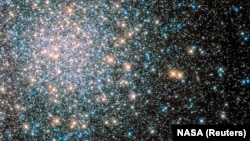The best place to look for alien life would be in globular star clusters, according to new research.
Clusters hold millions of stars - all within a relatively small area of around 100 light years across. They’re also old, almost as old as the Milky Way, having formed about 10 billion years ago on average.
"A globular cluster might be the first place in which intelligent life is identified in our galaxy," said lead author Rosanne DiStefano of the Harvard-Smithsonian Center for Astrophysics (CfA) during the meeting of the American Astronomical Society in Kissimmee, Florida.
There are about 150 globular clusters in the Milky Way, mostly on the outer areas.
However, clusters contain fewer of the heavy elements needed for the formation of new planets, which leads some to think they are not the best place to look for alien life.In fact, researchers say only one planet has been spotted around a cluster.
DiStefano argues that exoplanets have been found around stars “only one-tenth as metal rich as our Sun.” She also said that Earth-sized planets can form around metal rich or metal poor stars.
Another reason to think clusters might not be the best place to find life is that because of the concentration of stars. This means there would be a better chance of another star’s gravity “disrupting” a potential planetary system.
Researchers counter with the notion that the stars in clusters tend to be relatively dim and long-lived red dwarf stars. Any planets around those would be very close to its star, keeping it safe from stellar interlopers.
"Once planets form, they can survive for long periods of time, even longer than the current age of the universe," explains DiStefano.
That could mean any planet in a cluster could survive for billions of years, giving life ample time to form and evolve.
The proximity of the stars in a cluster would offer any alien civilization a better chance to explore nearby stars. For example, the nearest star to our solar system is four light years away. In a cluster, a neighboring star could be 20 times closer.
"We call it the 'globular cluster opportunity,'" said DiStefano. "Sending a broadcast between the stars wouldn't take any longer than a letter from the U.S. to Europe in the 18th century. "Interstellar travel would take less time, too. The Voyager probes are 100 billion miles [160 billion kilometers] from Earth, or one-tenth as far as it would take to reach the closest star if we lived in a globular cluster. That means sending an interstellar probe is something a civilization at our technological level could do in a globular cluster.”
Finding these planets, if they exist, will be hard.
The closest cluster is several thousand light years away, and given the crowding of stars, spotting a planet would be difficult. One opportunity might be to look for planets at the “outskirts of globular clusters.”










